By Rob Knies, Senior Writer, Microsoft Research
Networks are ubiquitous in the digital age. Whether you’re at home, in your car, on your phone, or sending files halfway around the world, you’re utilizing computer networks―working with them, communicating on them, being entertained by them.
They might be everywhere, but they’re far from perfect. In a myriad of ways, though, the Mobility, Networks, and Systems (MNS) group at Microsoft Research India is determined to change things for the better―at home and beyond.
Spotlight: Blog post
The team, in existence for less than three years, has matured to the point where it is addressing networking challenges in a variety of settings, from data centers to the individual home, and Venkat Padmanabhan wouldn’t have it any other way.
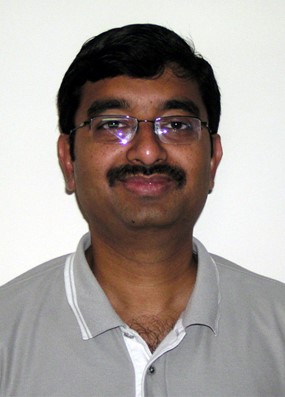
Venkat Padmanabhan
“Our group looks at the area of networked systems,” says Padmanabhan, principal researcher and MNS head, “and we’re trying to do work that is topical to address problems either globally, or specifically in India, to advance the state of the art.”
It’s a rich mine to explore, as Padmanabhan knows all too well. After almost nine years working at Microsoft’s Redmond headquarters, in April 2007, he accepted the challenge of building a new team in Bangalore. Two and half years later, he and his colleagues are beginning to reap the fruits of their labors.
The MNS group focuses on three aspects of networking research: mobility, network management, and network performance. And in each, team members can point proudly to projects that hold promise for improving the technology of tomorrow. The greater research community―and product groups within Microsoft―are paying avid attention.
Take the mushrooming area of mobility, for example. With mobile phones having penetrated markets across the globe, MNS is exploring ways to save the precious battery power that enables those devices’ capabilities. And the potential for advancement doesn’t end there.
“Battery energy is a big focus for us,” Padmanabhan says. “But the mobile device is not just a phone or a computer. It’s actually computing, communication, and sensing in one package. We’ve been working on a project that looks at how you could take the phones in users’ pockets and turn them into a distributed sensing platform.”
At a glance, network management might seem an issue solely for big companies’ system administrators, who need to make sure that their organizations’ digital central nervous systems continue to perform with a minimum of downtime. But such issues also extend to the home environment, where a lack of technical savvy can leave aggrieved users feeling really nervous.
“The problem is that you have a diversity of devices,” Padmanabhan explains, “and a situation where there is no network admin. When there are networking problems, the user is often helpless. We’re looking at how we can make things better.”
The big guys experience networking pains, too. Some service providers want to consolidate their efforts into massive data centers, and the savings in costs and management requirements are compelling. But that poses a bandwidth bottleneck.
“You might have a centralized infrastructure where it’s cheap to manage resources, but performance is substandard,” Padmanabhan states. “We want good performance with centralized infrastructure. We have a project that looks at how to bridge the divide.”
From the pocket to the home to the data center, the MNS group is tackling some of today’s toughest networking challenges. A few of their proposed solutions:
CoCoNet
Ramachandran Ramjee, a senior researcher who spent 10 years at Bell Labs before coming to Microsoft Research India, is working on a technique to make wide-area communication, the paradigm for data-center services, much more efficient by using protocol-independent compression technology.
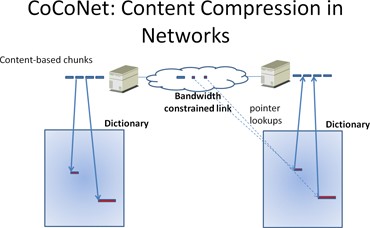 “Let’s say I e-mail you a large, 10-megabyte slide deck,” Padmanabhan says. “You make a few edits and copy it to a public share I can access. Now it’s 10 megabytes plus a kilobyte or so. Our system could develop a dictionary using those 10 megabytes of data on my end and on yours, because I sent it and you received it. When you need to send a file back, rather than send all 10 megabytes, it could just send a pointer to the dictionary and make a few rewrites to account for the kilobyte worth of changes.”
“Let’s say I e-mail you a large, 10-megabyte slide deck,” Padmanabhan says. “You make a few edits and copy it to a public share I can access. Now it’s 10 megabytes plus a kilobyte or so. Our system could develop a dictionary using those 10 megabytes of data on my end and on yours, because I sent it and you received it. When you need to send a file back, rather than send all 10 megabytes, it could just send a pointer to the dictionary and make a few rewrites to account for the kilobyte worth of changes.”
This method has two advantages. One, it is protocol-independent. It operates at a low level, beneath the application level, so no matter which protocol you’re using to communicate, if the bits have been seen before, they won’t need to be sent again.
The other advantage is that the resultant compression occurs between the client computer and the destination server. Other dictionary-based efforts have employed compression devices within the network, which limits the opportunity for compression and poses potential security challenges when end-to-end encryption is employed. A paper written by Ramjee and three colleagues from the University of Wisconsin-Madison―Redundancy in Network Traffic: Findings and Implications―explains the concept in detail.
“Ram’s work on CoCoNet,” Padmanabhan says, “has shown that you can operate end-to-end while still getting very good performance.”
NetPrints
This project, headed by Ranjita Bhagwan, aims to come to the rescue of beleaguered home users ill-equipped and disinclined to investigate thorny networking issues.
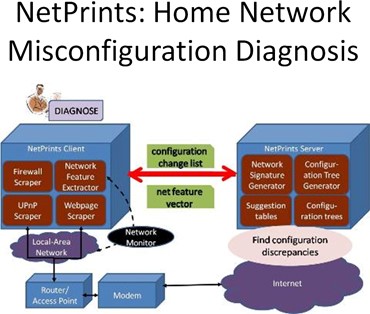 “You go to a store and buy a wireless router,” Padmanabhan says. “You plug it in, and things generally work, but your favorite application doesn’t. What do people do? They ask a friend, or maybe they open a search engine and type in the router model and the application and ask for help. If they’re lucky, they’ll find a post somewhere, but it’s a lot of work, and success is not guaranteed.”
“You go to a store and buy a wireless router,” Padmanabhan says. “You plug it in, and things generally work, but your favorite application doesn’t. What do people do? They ask a friend, or maybe they open a search engine and type in the router model and the application and ask for help. If they’re lucky, they’ll find a post somewhere, but it’s a lot of work, and success is not guaranteed.”
Bhagwan and her colleagues had the insight that, if one person is experiencing such an issue, the likelihood is that others have had similar problems and perhaps even have devised a solution. That information, obviously, would be of keen interest to the afflicted user.
NetPrints―the name refers to network-problem fingerprinting―has two components, one on a server and one that runs on the home machine. The latter collects configuration information from the home network and the router and sends it to the server. NetPrints then looks for similar occurrences―network fingerprints―and compares the configurations to determine the differences. It then either offers to fix things automatically or gives the user specific suggestions on what to do to fix the problem.
No personally identifiable information is exchanged, just configuration settings, and there is little or no human involvement. Basically, users who deploy NetPrints when they encounter a problem agree that, in exchange for a solution, they—or, rather, their home computers—will volunteer to provide information to help others with the same problem. The project is described in depth in a paper by Bhagwan, Padmanabhan, Microsoft Research India assistant researchers Bhavish Aggarwal and Tathagata Das, and colleagues from the Indian Institute of Technology Delhi and the University of California, San Diego, entitled NetPrints: Diagnosing Home Network Misconfigurations Using Shared Knowledge.
“We take the mass of data that we’ve gathered from lots of users and different settings,” Padmanabhan says, “and run machine learning to reduce it to a small, digestible form. This turns out to be a powerful means of doing diagnostics.”
Addressing Battery Power and Driving Conditions
He also points to a couple of different projects in the mobile space, one focusing on mobile networking to help reduce energy consumption and the other on enabling drivers to avoid hazardous or congested traffic conditions.
The former effort, driven by Vishnu Navda, addresses the fact that, for mobile phones, constant connectivity requires a prodigious amount of energy.
“When you look at energy consumption on a smartphone,” Padmanabhan says, “wireless communication is a big chunk of it. The baseline energy consumption of the phone could increase by as much as five times when you turn on Wi-Fi. GPS can also be very energy-expensive. We would like to turn on the radio, and incur the attendant energy cost, only when the radio has work to do. There’s no point having the radio on but idling, even if only intermittently. That’s simply a waste of precious battery energy.”
The solution, he says, is to make the communication become “bursty,” to push all communication bits in a burst of activity, then put the radio to sleep until it’s needed again. That might seem obvious upon explanation, but the insight actually took much measurement work to determine the level of energy necessary for radio transmission and the length of the transition period that follows that transmission.
“That’s when the realization came that, even for the cellular radio, where there’s a big gap between transmit energy and idle energy, it makes sense to do this kind of careful budgeting,” Padmanabhan says. “The focus in the mobile space has been on performance rather than on energy consumption. It’s only recently that there has been an appreciation that the energy per bit matters as much as the bits per second.”
Initial results on this research are reported in the paper titled Cool-Tether: Energy Efficient On-the-fly WiFi Hot-spots using Mobile Phones by Navda and his collaborators, both in the MNS group and at the University of California, Santa Barbara.
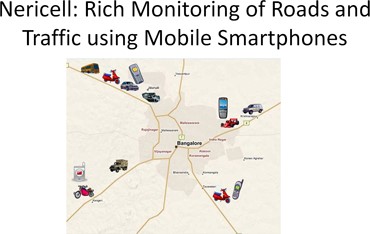
The group’s other effort in the mobile space is inspired by the reality of traffic. Researchers such as Eric Horvitz of Microsoft Research Redmond have been pursuing research on traffic monitoring, but almost all of those efforts have been set in developed nations, where driving conditions are much more homogenous. Given a road segment, if you measure the speed and volume of vehicles using it, you can develop a good idea of traffic conditions.
The situation can be starkly different in places like India. Vehicle speed still matters, of course, but the diversity of vehicles―bicycles, motorcycles, auto-rickshaws, cars, trucks, buses, all jostling for position―can be daunting. Road surfaces can vary widely, with some encumbered by potholes or bumps.
“Different kinds of vehicles could make different rates of progress on the same stretch of road,” Padmanabhan observes. “Smaller vehicles could zigzag their way through, while larger ones get stuck. There’s a lot of chaos, a lot of honking, braking and so on. There could be intersections where there’s no cop and no protocol, just a free-for-all.”
The MNS conjecture―which can be read in Nericell: Rich Monitoring of Road and Traffic Conditions Using Mobile Smartphones, written by former assistant researcher Prashanth Mohan, together with Padmanabhan and Ramjee―is that smartphones, with their sensor array of microphone, accelerometer, and GPS, could produce a more nuanced level of information.
“Nericell,” Padmanabhan says, “looks at how you use smartphones to automatically sense road and traffic conditions, in a way that’s efficient and accurate. We built a honk-detection system, a bump-detection system, braking detection. It’s far out yet plausible, which makes it exciting.”
Involving the Research Ecosystem
With such a variety of explorations, it’s little surprise that the MNS efforts have begun to attract the attention of the greater research community within India―and elsewhere. For example, in June 2009, Microsoft Research India, collaborating with the Indian Institute of Science (IISc), hosted a Summer School on Networking. The course, which featured several renowned experts in the field, gave an audience largely consisting of students, exposure to cutting-edge research and enabled the participants to mingle with the speakers.
“It was a great success,” Padmanabhan reports. “We had eight speakers from around the world―a couple of people from Microsoft Research, professors from Berkeley, Stanford, UC San Diego, Princeton, and leading Indian universities IISc and the Indian Institute of Technology Madras. The reaction we got from the attendees and the speakers was very, very positive.”
MNS, and Microsoft Research India in general, also have been attracting interns and visitors from far and wide. A large number of interns at the lab come from the United States and other countries, though they certainly could get internships in some of the most reputed companies and institutions back at home.
“It’s nice to see that happening,” Padmanabhan understates. “If we weren’t doing good work and getting prominence, people wouldn’t want to come here.”
Quality People, Quality Work
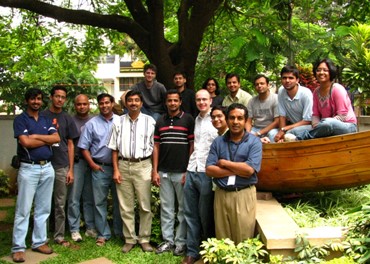
Venkat Padmanabhan (fifth from left) with his Mobility, Networks, and Systems group.
It seems clear that Padmanabhan’s team has established itself as one of the most prominent networking groups in India. That, he maintains, reflects the quality of the researchers his team has attracted.
“We’ve built a good team,” he smiles. “It’s a small team, but the people are doing great work, and they’re jelling together well. We’re getting projects to the point where papers are getting published at the top conferences. We are earning the respect and recognition of our peers.”
Where will all this activity lead? Padmanabhan cites a couple of directions.
“I certainly hope,” he says, “that we will make a big, positive impact on the larger research ecosystem in India: a lot more activity happening, a lot more students and professors and other researchers at other labs involved in this kind of work, a greater presence in the big international conferences.
“From a technology viewpoint, I hope the work we’ve been doing and that we continue to do will advance the state of the art and impact the real world. We’ve already started to do that, but, hopefully, we’ll have bigger, better things, technical advances that are positive for Microsoft and for the community as a whole.”





